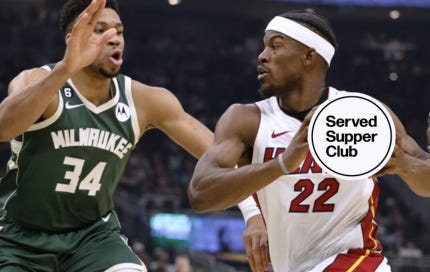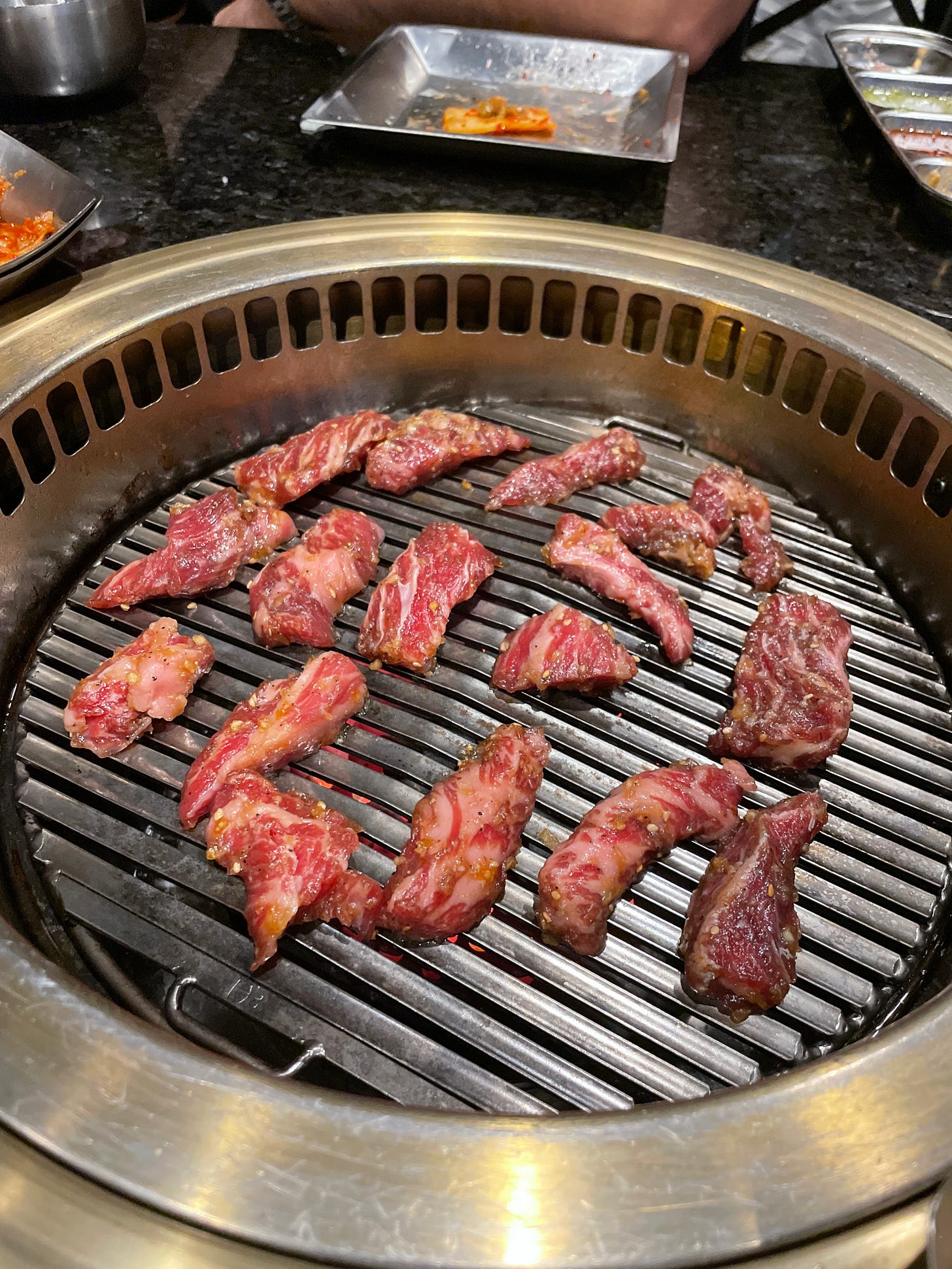Special Edition: Meat. Broth. Noodles. Rice. Kimchi
I eat galbi tang at least 3 times a week. Let me tell you why
You’re sitting in a dark restaurant. The light above the table is bright and washes out the scene around you. Across from you sits someone new, and the conversation is flowing.
“So do you come here a lot?”
“Do you live nearby?”
“What do you do for work?”
“Are you from Philly originally?”
Walking here by yourself, it was just you, your thoughts, and maybe a bit of nervousness. Your date is probably working through the same. The result is a rapid-fire small-talk explosion. And it’s fun! The energy, the excitement, the possibility. What was her name agai -
“Hi! Have we had a chance to look at the menu?”
Oh yeah. You’re at a restaurant. The purpose of the building in which you find yourself currently is to provide food for you and your date and then, in exchange, collect payment from you alone. You haven’t yet opened the menu. The person whose job it is to give you the food is growing increasingly frustrated because this is the third time they’ve checked in. Shit.
“Yeah … we’ll have the …”
You break the seal on the menu, desperately scanning the pages for an appetizer to buy you some much needed time. Eyes darting from maki to nigiri to A5 wagyu (no shot). Finally, you see it. The ultimate crowd pleaser.
“Spicy tuna crispy rice.”
In your head you just sank a clutch basket. Himmy Butler, Game 5 vs. the Bucks. Your server nods, scribbles something in the notepad, and turns to walk away. You look back up at your date, smiling. So … where were we.
“You know I’m a vegetarian right?” Riiiiiiiight.
We’ve all been there before. Picking what you want to eat at any given time is a decision that comes with a lot of baggage. Even if it’s an easy choice for you in some contexts, there are always lots of factors that influence your choosing what you did. In my first date gone wrong, there was time pressure, little preparation, and no knowledge of the person sitting across from me. For your dinner tonight, it could be a whole host of things. Maybe the General Tso’s was on sale at Trader Joe’s. Or maybe your team at work is having a happy hour. All of that said, the infinite number of economic, social, personal, or otherwise extenuating circumstances that can go into choosing what to eat often point for me to the same dish. Galbi Tang.
It’s a Korean short rib stew. When literally translated, the name of the dish is “rib boiling water.” In my experience, Galbi Tang is a clear beef broth with tender short ribs, potato starch noodles, and daikon. I’m not Korean, and I’m sure there are countless variations. However, from what I understand, it usually comes with white rice. It always comes with kimchi.
My life after graduating college has been tumultuous. I’ve had two jobs, lived in two different cities, experienced one breakup, been to six different countries, and slept on countless New York City couches. Developing a consistent routine has been difficult through the changes, but Galbi Tang is a unifying force through it all. I remember when I first tasted it.
Park 27 is a Korean BBQ restaurant down the street from my first apartment in Atlanta. It quickly became a staple in the dinner rotation due to its portion sizes, meat quality, and addictive doenjang (Korean bean paste). When I think back to the very few moments of free time that I had during my stint in the ATL, the majority of them were spent with my roommates at Park 27. We loved to experiment with different seasonings, sauces, sides dishes - and of course new menu items. Mandu. Seafood pancakes. Galbi Tang. Et cetera.
It was my first, and still favorite, Galbi Tang. There’s something about human nature where we tend to romanticize “firsts.” Maybe there is some of that at play here, but this Galbi Tang is definitely unique compared to others that I’ve now had. Most prominently, the rib bones are long. I remember them being the kind of bones that you could pick up and eat meat off of like a lollipop. It’s at Park 27 where I developed my strategy for the perfect bite. Fill a spoon up with rice, add a bit of meat, a bit of daikon, a bit of scallion, and a bit of kimchi. Then submerge the whole combination in the broth, and enjoy. I still use that method today.
After just dipping my toe into the world of Galbi Tang at Park 27, my time in Atlanta abruptly came to a close. I packed my things and headed back up to Philadelphia for a new job. It really is the land of opportunity.
For those of you who don’t know, I went to college at Penn in Philadelphia. Given that experience, I thought that moving there professionally would be an easy transition. Moving out of Atlanta, flying to Philadelphia, and then moving into my place here was a continuous blur. Then, all of a sudden, time slowed down. I was laying in my bed that first weekend when it hit me. The Philadelphia that I knew was the people in it. And most of those people are gone.
What remains, however, are all of the restaurants, parks, and other places that I used to frequent. One that was familiar - and close to my apartment - is Seorabol in Rittenhouse Square. Chris Cho, the chef there, came to speak to my Asian American Food class at Penn. By far the highlight of his lecture that day was when he called himself “the Drake of Korean food.” He’s awesome, and hilarious, and he makes the same face in every photo on his website.
I walked into Seorabol for the first time and immediately grabbed a menu. Right there, the very first thing on the soups / stews section was my old reliable. Galbi Tang. Chris’s rendition of the dish is less extravagant than Park 27’s. The ribs are smaller, the noodles are thicker, and the broth is lighter. It’s a meal that will keep you light on your feet, whereas you’ll want a nap after Park 27. Differences aside, the Seorabol Galbi Tang takes me back to where I want to go. When I close my eyes, I’m at that table in Atlanta. Enjoying one of those rare moments off from work with people that I love.
I think the reason why I eat Galbi Tang multiple times per week is that I’m compelled by one of humanity’s strongest behavioral forces. Nostalgia. That fleeting feeling of being back in the good ol’ days that certain foods, smells, or sounds can conjure up. It’s the reason why I occasionally crave Kraft macaroni and cheese and worship Waffle House as an institution. When you feel nostalgia, it can overpower all of the other bullshit that influences your decision making. Lean into it. Feel good. And remember where you’ve come from. Even if that means eating like a Korean grandma.
Thanks for reading,
Served Supper Club









The himothy butler of food newsletters strikes again